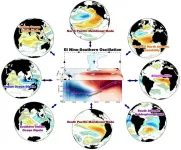(Press-News.org) Bacteria populate virtually every habitat on Earth, including within and on our own bodies. Understanding and engineering bacteria can lead to new methods for diagnosing, treating, and preventing infections. Additionally, it presents opportunities to protect crops from disease and create sustainable cell factories for chemical production, reducing environmental impact — just a few of the many benefits to society. To unlock these advantages, scientists need the ability to manipulate the genetic content of these bacteria. However, a longstanding bottleneck in genetically engineering bacteria has been the efficient transformation of DNA, the process of introducing foreign DNA into a cell. This has limited its application to only a small subset of microbes.
A major obstacle is the presence of restriction-modification systems. These protective systems mark the bacterial genome with a unique methylation pattern and destroy incoming foreign DNA lacking this pattern. Overcoming this barrier requires adding the bacterium's pattern to the DNA, a process that is strain-specific and involves multiple DNA methyltransferases. These enzymes attach methyl groups, small chemical groups containing one carbon atom bonded to three hydrogen atoms, to DNA bases. Current methods to replicate or circumvent these DNA methylation patterns are labor-intensive and not easily scalable, necessitating new approaches.
Addressing this challenge, a team led by the Helmholtz Institute for RNA-based Infection Research (HIRI), a site of the Braunschweig Helmholtz Centre for Infection Research (HZI) in cooperation with the Julius-Maximilians-Universität Würzburg (JMU), has introduced a novel approach to recreate such patterns and enhance DNA transformation. They called it IMPRINT, which stands for Imitating Methylation Patterns Rapidly IN TXTL. As part of this method, the researchers use a cell-free transcription-translation (TXTL) system—a liquid mixture that can produce ribonucleic acids (RNAs) and proteins from added DNA—to express a bacterium’s specific set of DNA methyltransferases. The enzymes are then used to methylate DNA prior to its delivery into the target bacterium.
A wholly new application
“IMPRINT represents an entirely new use of TXTL. While TXTL is widely employed for various purposes, including producing hard-to-express proteins or as affordable diagnostic tools, it has not previously been utilized to overcome barriers to DNA transformation in bacteria,” says Chase Beisel, head of the RNA Synthetic Biology department at the HIRI and professor at the JMU Medical Faculty. He spearheaded the study in collaboration with researchers from North Carolina State University (NC State) in Raleigh, USA. Their findings were published today in the journal Molecular Cell.
Compared to existing methods, IMPRINT offers speed and simplicity: “Current approaches require either laboriously purifying individual DNA methyltransferases or expressing them in E. coli, which often proves cytotoxic,” says Justin M. Vento, first author of the study who completed the work as a PhD student in the Department of Chemical and Biomolecular Engineering at NC State. “These methods can take days to weeks and only reconstitute a fraction of the bacterium's methylation pattern.”
The researchers demonstrated that IMPRINT could express a diverse array of DNA methyltransferases. Furthermore, these enzymes could be combined to recreate complex methylation patterns. This greatly enhanced DNA transformation in bacteria such as the pathogen Salmonella and the probiotic Bifidobacteria, including a challenging-to-transform strain of the latter, less-studied bacterium.
The basis for new antibiotics and cell-based therapies
The potential applications in modern medicine and research are extensive: IMPRINT can improve DNA transformation in clinical isolates of bacterial pathogens and in bacteria that combat infections, such as commensal bacteria or those producing antibacterial compounds. Genetic modification of these microbes could lead to new classes of antibiotics and cell-based therapies.
The research team aims to expand the use of IMPRINT: “We want to make a wide variety of bacterial pathogens genetically tractable for research,” Beisel says. He hopes that IMPRINT will be widely adopted by the research community: “Until now, certain bacteria have been favored as models simply because they are easier to genetically manipulate. We are hopeful that, by using IMPRINT, researchers will be able to focus on the most important bacterial strains, such as those with increased virulence or antibiotic resistance,” Beisel concludes.
Funding:
The study was supported through funding by the US National Science Foundation, the German Research Foundation, the Novo Nordisk Foundation, the Camille and Henry Dreyfus Foundation, and the Bavarian State Ministry for Science and the Arts through the research network bayresq.net.
Helmholtz Centre for Infection Research:
Scientists at the Helmholtz Centre for Infection Research (HZI) in Braunschweig and its other sites in Germany are engaged in the study of bacterial and viral infections and the body’s defence mechanisms. They have a profound expertise in natural compound research and its exploitation as a valuable source for novel anti-infectives. As member of the Helmholtz Association and the German Center for Infection Research (DZIF) the HZI performs translational research laying the ground for the development of new treatments and vaccines against infectious diseases. www.helmholtz-hzi.de/en
Helmholtz Institute for RNA-based Infection Research:
The Helmholtz Institute for RNA-based Infection Research (HIRI) is the first institution of its kind worldwide to combine ribonucleic acid (RNA) research with infection biology. Based on novel findings from its strong basic research program, the institute’s long-term goal is to develop innovative therapeutic approaches to better diagnose and treat human infections. HIRI is a site of the Braunschweig Helmholtz Centre for Infection Research (HZI) in cooperation with the Julius-Maximilians-Universität Würzburg (JMU) and is located on the Würzburg Medical Campus. More information at www.helmholtz-hiri.de.
END
Unlocking the world of bacteria
HIRI researchers introduce novel approach to DNA transformation and genetic mutation of bacteria
2024-06-26
ELSE PRESS RELEASES FROM THIS DATE:
Argonne to support new AI for science projects as part of the National AI Research Resource Pilot
2024-06-26
The U.S. Department of Energy’s (DOE) Argonne National Laboratory will support three innovative artificial intelligence (AI)-driven science projects as part of the first round of awards from the National Artificial Intelligence Research Resource (NAIRR) Pilot.
Led by the National Science Foundation (NSF) in collaboration with DOE and several partners, the NAIRR Pilot aims to provide researchers and students with expanded access to key AI resources and data. NAIRR’s ultimate goal ...
Stress testing pension funds: Lithuanian researchers lead global innovation
2024-06-26
“We wanted to investigate how second pillar pension funds react to financial crises and how to protect them from the crises,” says Kaunas University of Technology (KTU) professor Dr Audrius Kabašinskas, who, together with his team, discovered a way to achieve this goal. The discovery in question is the development of stress tests for pension funds. Lithuanian researchers were the first in the world to come up with such an adaptation of the stress tests.
Stress tests are usually carried out on banks or other financial institutions to allow market regulators to determine and assess their ability to withstand adverse economic conditions.
According to the professor at ...
Multivitamin use and mortality risk in 3 prospective US cohorts
2024-06-26
About The Study: Multivitamin use was not associated with a mortality benefit in this cohort study of U.S. adults. Still, many adults report using multivitamins to maintain or improve health.
Corresponding Author: To contact the corresponding author, Erikka Loftfield, Ph.D., M.P.H., email erikka.loftfield@nih.gov.
To access the embargoed study: Visit our For The Media website at this link https://media.jamanetwork.com/
(doi:10.1001/jamanetworkopen.2024.18729)
Editor’s Note: Please see the article for additional information, including other authors, author contributions and affiliations, conflict of interest and financial disclosures, ...
Solar technology: Innovative light-harvesting system works very efficiently
2024-06-26
In order to convert sunlight into electricity or other forms of energy as efficiently as possible, the very first step is an efficient light-harvesting system. Ideally, this should be panchromatic, i.e. absorb the entire spectrum of visible light.
The light-collecting antennae of plants and bacteria are a model for this. They capture a broad spectrum of light for photosynthesis, but are very complex in structure and require many different dyes to transmit the energy of the absorbed light and focus it on a central point.
The light-harvesting systems developed by humans to date also have disadvantages:
Although ...
Brain’s ‘escape switch’ controlled by threat sensitivity dial
2024-06-26
Neuroscientists have discovered how the brain bidirectionally controls sensitivity to threats to initiate and complete escape behaviour in mice. These findings could help unlock new directions for discovering therapies for anxiety and post-traumatic stress disorder (PTSD).
The study, published today in Current Biology, outlines how researchers at the Sainsbury Wellcome Centre at UCL studied a region of the brain called the periaqueductal gray (PAG), which is known to be hyperactive in people with anxiety and PTSD. Their ...
Improving prostate cancer screening for transgender women
2024-06-26
Transgender women are still at risk for prostate cancer. A new study led by Cedars-Sinai Cancer investigators, published in the peer-reviewed Journal of the American Medical Association, concludes that current screening guidelines could miss early-stage prostate cancer in transgender women on hormone therapy.
The prostate, a small gland that helps make semen, also produces a protein called prostate-specific antigen, or PSA. Blood levels of PSA tend to be elevated in people who have prostate cancer, and the PSA test, which measures those levels, is a common prostate ...
For healthy adults, taking multivitamins daily is not associated with a lower risk of death
2024-06-26
What: A large analysis of data from nearly 400,000 healthy U.S. adults followed for more than 20 years has found no association between regular multivitamin use and lower risk of death. The study, led by researchers at the National Institutes of Health’s National Cancer Institute, was published June 26, 2024, in JAMA Network Open.
Many adults in the United States take multivitamins with the hope of improving their health. However, the benefits and harms of regular multivitamin use remain unclear. ...
From takeoff to flight, the wiring of a fly's nervous system is mapped
2024-06-26
Work is underway on a wiring diagram of the motor circuits in the central nervous system that control muscles in fruit flies. This connectome, as the wiring diagram is called, is already providing detailed information on how the nerve coordination of leg movements differs from that controlling the wings.
Although fruit flies seem like simple creatures, the researchers said that their motor system contains “an unexpected level of complexity.”
“A typical fly motor neuron receives thousands of synapses from hundreds ...
A chip-scale Titanium-sapphire laser
2024-06-26
As lasers go, those made of Titanium-sapphire (Ti:sapphire) are considered to have “unmatched” performance. They are indispensable in many fields, including cutting-edge quantum optics, spectroscopy, and neuroscience. But that performance comes at a steep price. Ti:sapphire lasers are big, on the order of cubic feet in volume. They are expensive, costing hundreds of thousands of dollars each. And they require other high-powered lasers, themselves costing $30,000 each, to supply them with enough energy to function.
As a result, Ti:sapphire lasers ...
El Niño forecasts extended to 18 months with innovative physics-based model
2024-06-26
Across Asia, the Pacific Ocean, and the Americas, El Niño Southern Oscillation (ENSO) brings variations in winds, weather, and ocean temperature that can cause droughts, floods, crop failures, and food shortages. Recently, the world has experienced a major El Niño event in 2023-2024, dramatically impacting weather, climate, ecosystems, and economies globally. By developing an innovative modeling approach, researchers from the School of Ocean and Earth Science and Technology (SOEST) at the University ...
LAST 30 PRESS RELEASES:
Current Molecular Pharmacology achieves a landmark: real-time CiteScore advances to 7.2
Skeletal muscle epigenetic clocks developed using postmortem tissue from an Asian population
Estimating unemployment rates with social media data
Climate policies can backfire by eroding “green” values, study finds
Too much screen time too soon? A*STAR study links infant screen exposure to brain changes and teen anxiety
Global psychiatry mourns Professor Dan Stein, visionary who transformed mental health science across Africa and beyond
KIST develops eco-friendly palladium recovery technology to safeguard resource security
Statins significantly reduce mortality risk for adults with diabetes, regardless of cardiovascular risk
Brain immune cells may drive more damage in females than males with Alzheimer’s
Evidence-based recommendations empower clinicians to manage epilepsy in pregnancy
Fungus turns bark beetles’ defenses against them
There are new antivirals being tested for herpesviruses. Scientists now know how they work
CDI scientist, colleagues author review of global burden of fungus Candida auris
How does stroke influence speech comprehension?
B cells transiently unlock their plasticity, risking lymphoma development
Advanced AI dodel predicts spoken language outcomes in deaf children after cochlear implants
Multimodal imaging-based cerebral blood flow prediction model development in simulated microgravity
Accelerated streaming subgraph matching framework is faster, more robust, and scalable
Gestational diabetes rose every year in the US since 2016
OHSU researchers find breast cancer drug boosts leukemia treatment
Fear and medical misinformation regarding risk of progression or recurrence among patients with breast cancer
Glucagonlike peptide-1 receptor agonists and asthma risk in adolescents with obesity
Reviving dormant immunity: Millimeter waves reprogram the immunosuppressive microenvironment to potentiate immunotherapy without obvious side effects
Safety decision-making for autonomous vehicles integrating passenger physiological states by fNIRS
Fires could emit more air pollution than previously estimated
A new way to map how cells choose their fate
Numbers in our sights affect how we perceive space
SIMJ announces global collaborative book project in commemoration of its 75th anniversary
Air pollution exposure and birth weight
Obstructive sleep apnea risk and mental health conditions among older adults
[Press-News.org] Unlocking the world of bacteriaHIRI researchers introduce novel approach to DNA transformation and genetic mutation of bacteria







